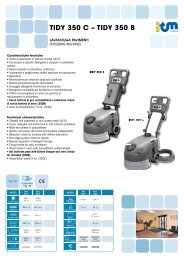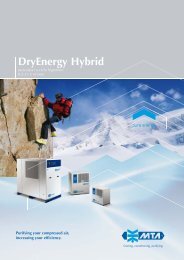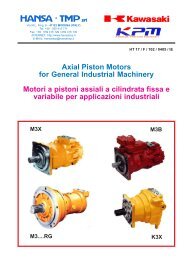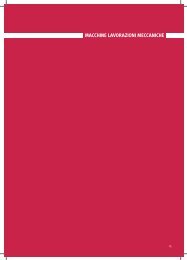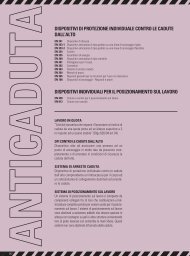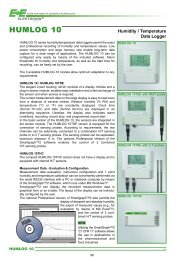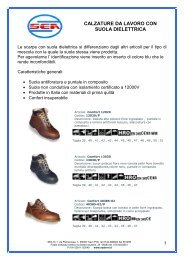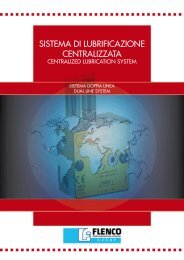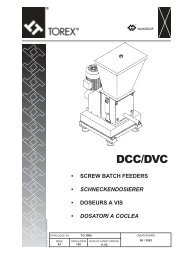Create successful ePaper yourself
Turn your PDF publications into a flip-book with our unique Google optimized e-Paper software.
<strong>RVS</strong> • <strong>RVC</strong>- RESIDUAL RISKS02.09- RESTRISIKEN- RISQUES RESIDUELS- RISCHI RESIDUI TO.310.M. 432Risks due to ElectricityMake the motor connections accordingto the indications givenin the Manual (Chap.2 Sect.“ELECTRICAL CONNECTIONS”).The rotary valve is supplied withan electric motor without a powercables for connection to themains.During machine commissioningoperations, the operator musttake care to connect the cablescorrectly, carrying out the operationsin complete safety as envisagedby the standards (CEIEN 60204-1) regarding the useof electricity. It is important toensure that the valve body isconnected to the plant’s earthcircuit to avoid risk of electrostaticdischarges. The earthingconnection must be made by theinstaller.Risks due to high temperatures.During the course of normal operationsor maintenance orcleaning, the operator can comein contact with parts having temperatureexceeding 60°C, withthe machine stopped.The temperature level is, however,greatly conditioned by thevalve application conditions(power absorbed by the motor,material conveyed, work cycle):the valve running in phase mayalso involve higher temperaturesespecially if a mechanical speedchanger is used.It is therefore the installer’s responsibilityto place warning noticeswhich (if the hazard exists)indicate the hazard due tothe presence of very hot surfacesand the obligation for theoperator to use personal protectiondevices, such as safetygloves.Risiken durch elektrischeEnergieDie Anschlüsse des Motors gemäßden Angaben des Handbuchsausführen (Kap. 2 Abs.„ELEKTRISCHE ANSCHLÜSSE”).Die Zellenradschleuse wird mitElektromotor ohne Netzkabel geliefert.Während der Inbetriebnahmemuss der Bediener dafür sorgen,dass die Kabel korrekt angeschlossenwerden, indem er dieArbeiten auf der sicheren Seiteausführt, so wie es die Norm(CEI EN 60204-1) zur Benutzungelektrischer Energie vorsieht. Esist wichtig, dass das Schleusengehäusean den Erdungskreisder Anlage angeschlossen wird,um die Gefahr elektrostatischerAufladung zu vermeiden. Die Erdungmuss vom Elektriker vorgenommenwerden.Risiken durch hohe Temperaturen.Beim normalen Betrieb oder beiWartungs- oder Reinigungsarbeitenkann der Bediener bei abgeschaltetemGerät mit Flä-chenin Berührung kommen, die eineTemperatur über 60° C aufweisen.Die Temperatur hängt im wesentlichenvon den Bedingungen derSchleusenanwendung ab (Leistungsaufnahmedes Motors, Fördergut,Arbeitszyklus): Die Einlaufphaseder Zellenrad-schleusekann außerdem höhere Temperaturenbedingen, insbe-sondere,wenn ein mecha-nischesRegelgetriebe einge-setzt wird.Es ist daher Aufgabe des Installateurs,Warnschilder anzubringen,die (falls die Gefahr besteht)die Gefahr angeben, die aufOberflächen mit hoher Temperaturhinweisen, wie auch dieVerpflichtung für den Bediener,persönliche Schutzausrüstungenzu verwenden, insbesondereSchutzhandschuhe.Risques dus à l’Energie ElectriqueEffectuer les raccordements dumoteur en suivant les indicationsdu manuel (Chap.2 Sect. « RAC-CORDEMENTS ELECTRI-QUES »).Le distributeur alvéolaire est fourniavec un moteur électrique sanscâbles de raccordement au secteur.Pendant l’opération de mise enservice de la machine l’opérateurdevra réaliser le raccordementdes câbles en prenant toutesles précautions de sécuritécomme prévu par la réglementation(CEI EN 60204-1 ) sur l’utilisationde l’énergie électrique. Ilest important que le corps du distributeursoit raccordé au circuitde mise à la terre de l’installation,pour éviter les risques dedécharges électrostatiques. Lamise à la terre doit être réaliséepar l’installateur.Risques dus aux températuresélevéesPendant le fonctionnement ordinaireou les interventions d’entretienet de nettoyage, l’opérateurpeut entrer en contact, lamachine étant arrêtée, avec desparties dont la température dépasse60°C.Le niveau de la température estfortement conditionné par lesconditions d’application du distributeur(puissance absorbéepar le moteur, matériau transporté,cycle de travail) : la phase derodage du distributeur de la vannepeut aussi comporter destempératures plus élevées, surtouten cas d’utilisation d’un variateurmécanique.L’installateur doit donc placer desplaques signalétiques de danger(si le danger subsiste) qui indiquentle danger dû à la présencede surfaces à haute températureet l’obligation pour l’opérateurd’utiliser des équipementsde protection individuelle, en particulierdes gants de protection.Rischi dovuti ad Energia ElettricaEseguire i collegamenti del motoreseguendo le indicazioni delmanuale(Cap.2Sez.”COLLEGAMENTI ELETTRI-CI”).La rotovalvola viene fornita conmotore elettrico senza cavi dicollegamento alla rete.Durante l’operazione di messa inservizio della macchina l’operatoredovrà aver cura di collegarecorrettamente i cavi svolgendole operazioni in sicurezzacome prevede la normativa (CEIEN 60204-1 ) sull’utilizzo di energiaelettrica. E’ importante che ilcorpo valvola sia collegato al circuitodi terra dell’impianto, ondeevitare rischi da cariche elettrostatiche.Il collegamento di terradeve essere eseguito dall’installatore.Rischi dovuti ad alte temperatureNel corso del normale funzionamentoo di interventi manutentivie di pulizia, l’operatore può entrarein contatto, a macchina ferma,con parti aventi superfici atemperatura maggiore di 60°C.Il livello di temperatura è comunquefortemente condizionato dallecondizioni di applicazione dellavalvola (potenza assorbita dalmotore, materiale trasportato,ciclo di lavoro) : la fase di rodaggiodella valvola può inoltre comportaretemperature più elevate,specialmente se si utilizza unvariatore meccanico.E’ quindi compito dell’installatoreposizionare apposite targhe monitorieche (qualora sussita ilpericolo) indichino il pericolo dovutoalla presenza di superficiad elevata temperatura e l’obbligoper l’operatore di utilizzaredispositivi di protezione individuale,in particolare guanti protettivi.



